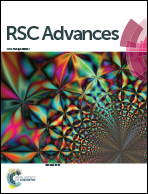Nanorod-assembled NiCo2O4 hollow microspheres assisted by an ionic liquid as advanced electrode materials for supercapacitors†
Abstract
In this work, nanorod-assembled NiCo2O4 hollow microspheres have been successfully prepared by an ionic liquid-assisted hydrothermal method for the first time. The as-obtained nanorod-assembled NiCo2O4 hollow microspheres manifest a high specific capacitance (764 F g−1 at 2 A g−1), exceptional rate capability (53.5% of capacity retention at 30 A g−1) and good cycling stability (101.7% of initial capacity retention after 1500 cycles). The superior electrochemical performance can be attributed to the unique hollow micro-/nanostructure, which can provide more active sites for the faradic redox reaction, provide an easy electrolyte penetration path and alleviate the volume change during the charge–discharge process. These results suggest that the nanorod-assembled NiCo2O4 hollow microspheres could be promising electrode materials for supercapacitor applications. Additionally, this synthetic method can be extended to the fabrication of other hollow micro-/nanostructure materials for energy and other related applications.



 Please wait while we load your content...
Please wait while we load your content...